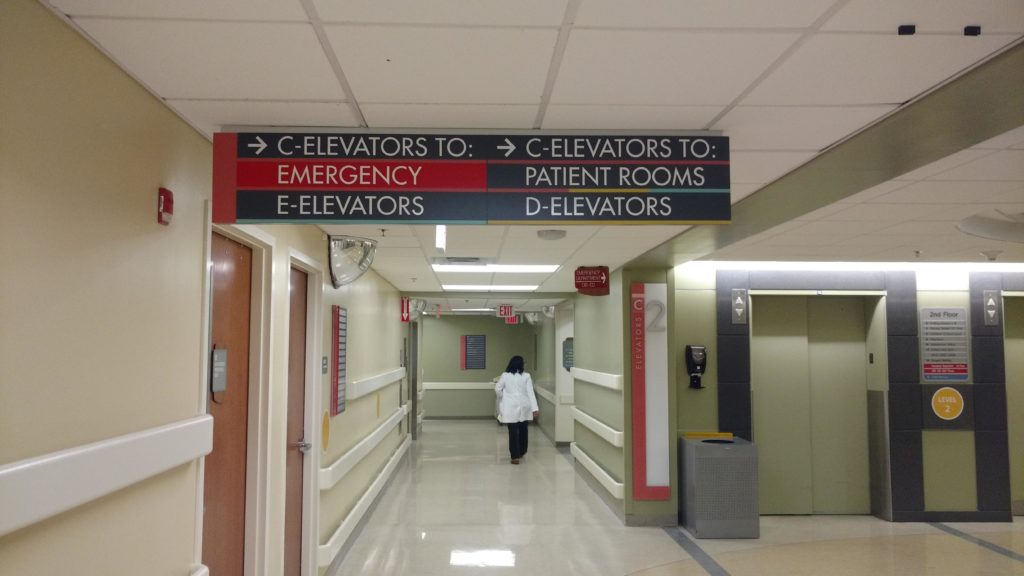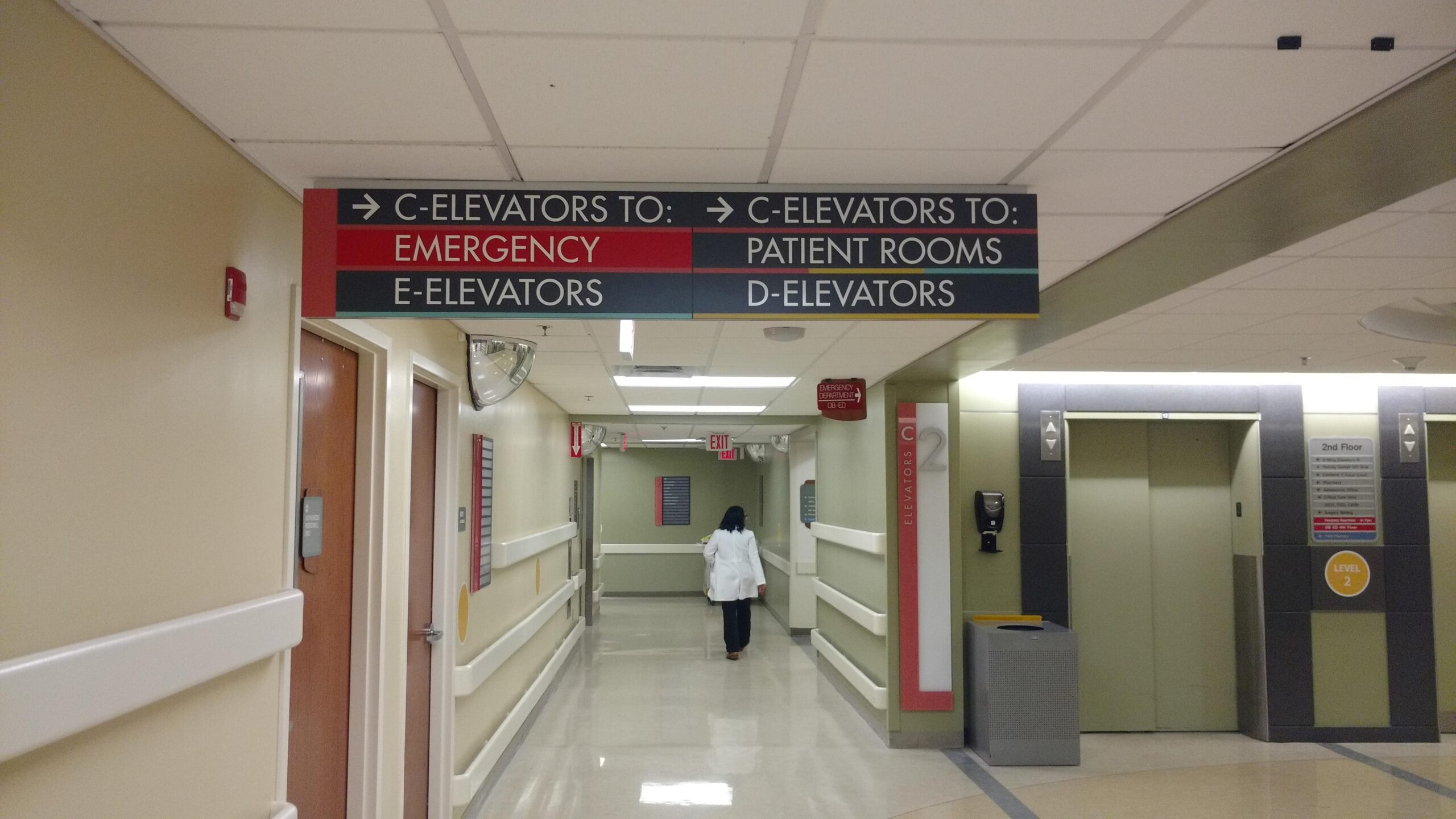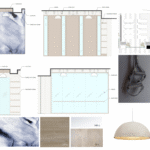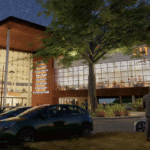
Hospital Wayfinding: 5 Navigation Problems and How to Solve Them
Hospitals function like small cities. There are thousands of employees who work there each day, from surgeons to cashiers at the gift shop. Patients also visit the hospital and need to find the doctor they are meant to see or the department they need for treatment. This is where hospital wayfinding comes in. You need effective hospital wayfinding to help all of these people find their way.
Creating effective hospital wayfinding isn’t easy; however, we have the experience that allows us to do it well. Here are five common problems that hospitals face and how to solve them using creative and modern wayfinding and signage solutions.
1. Hospitals Size Causes Patients to Get Lost
The modern hospital takes on the same size and feel of a college campus. There are multiple stories, wards, and even buildings that are connected via roads or elevated walkways. These buildings can be incredibly intimidating for patients who are already worried about their health and aren’t sure where to go. Even a small hospital can seem intimidating if it has a complex layout.
Dr. Janet R. Carpman of Carpman Grant Associates found that a third of first-time visitors to hospitals get lost. Furthermore, a quarter of hospital workers are confused about the location of certain important locations. Considering a campus like UAB Medicine is spread over 100 city blocks, it’s no wonder people get lost so frequently.
Solution
For a large campus where people can easily get lost, turn to interactive kiosks. Let people use a digital screen to search for an office or room, with suggestions for common landmarks like the cafeteria. These kiosks will then provide directions to the location so visitors can figure out where to go.
2. Healthcare Providers Waste Time Offering Directions
Without clear wayfinding, the burden for giving directions falls on the staff. Doctors and nurses get stopped as they walk through the halls and have to help patients, making them late and distracting them from their work.
In fact, lost patients cost hospitals money. Patients miss appointments or arrive late, pushing back wait times and limiting how many people medical professionals can meet with. This means fewer people get help or hospitals have to pay overtime. Carpman reports that poor wayfinding cost Atlanta’s Emory University $200,000 every year.
Solution
Along with kiosks, hospitals can use signage to guide customers. Use large, bright interior sign systems with clear instructions in English and in major languages spoken in that region (Spanish, French in parts of the Northeast, and Chinese or Korean on parts of the West Coast). For one example, look at the wayfinding we created for Lakeland Regional Hospital in Florida. We made large, clear signs to help people find the floors they need.
Related: A Practical Guide to Hospital Signage and Wayfinding
3. Stressed Patients Aren’t Able to Read Clearly
Visiting the hospital is a stressful time for many people. Along with emergency room visits, where people are scared and in shock from various accidents, a large number of people suffer from nosocomephobia, or the fear of hospitals. Often, the hospital itself isn’t the fear, but rather fears of blood, death, or needles.
This means that even if patients just need a routine check-up, they likely feel stressed and nervous as they navigate the hallways.
Solution
Most hospitals go out of their way to create positive experiences as a way to calm patient nerves. They use natural lighting and comforting decorations. Good wayfinding can also help scared patients. By color-coding different floors and using bright colors for each one, patients can navigate hallways easier. They might not remember that their loved one is in surgery on the third floor, but they will remember the green floor or the purple hallway if it stands out.
4. Patients Need to Avoid Certain Areas
Lost patients aren’t just an inconvenience for doctors and a drain on resources, they can also be downright dangerous. There are several places in hospitals where patients shouldn’t be to protect their safety and the safety of others.
Think about the emergency department and the importance of making way for arriving ambulances. If your patients park outside of this loading zone, even just to unload themselves, they can prevent emergency workers from coming and going. Within an emergency center, each of those precious moments counts.
Solution
Clear parking directions can guide patients to visitor spaces or emergency spaces for unloading. You can see examples of this through our work at Sarasota Memorial Hospital. Patients can easily find parking and know how to navigate the garage even if they have hospital anxiety.
Additionally, interior wayfinding can keep patients away from wards where they are not allowed. These include areas where there are x-rays as well as sensitive levels with the morgue or ICU. In the case of hospital wayfinding, the right signage can direct patients away from danger or at least halls that they don’t want to see.
Related: A Wayfinding Evolution in Healthcare
5. Hospitals Can’t Create Positive Visitor Experiences
Hospitals strive to give patients and visitors a positive experience. They want patients to walk away in better health and with a positive opinion of the facility. But often, hospitals struggle with creating a space that feels comfortable and easy to navigate. But, you can use both signage and wayfinding tools to improve patient and visitor experience.
Look at what we did for Joe DiMaggio’s Children’s Health Specialty Center in Wellington, Florida. We use environmental branding to give it a sports theme and added bright colors across the walls. These designs make the hospital seem fun and help patients relax. Calm patients are better able to figure out where they are going and are eager to explore.
Solution
The colors, logos, fonts, and lighting you choose for your hospital wayfinding signage will all contribute to the experiences of your patients. They will determine how much your patients trust you and how safe they feel agreeing to treatment. If you don’t think a logo is that powerful, then you don’t know signage.
Learn More About Hospital Wayfinding
Hospital wayfinding is important on both a macro and micro level. Lost patients and a poorly organized layout can cause major problems and take up resources. Not only can clear signage and wayfinding tools save money, but they can also help your patients. If a stressed family feels better walking around the halls, isn’t it worth the investment?
To learn more about your hospital wayfinding improvement options, reach out to our team at Creative Sign Designs to see how we can help you overcome navigation problems on your healthcare campus.





